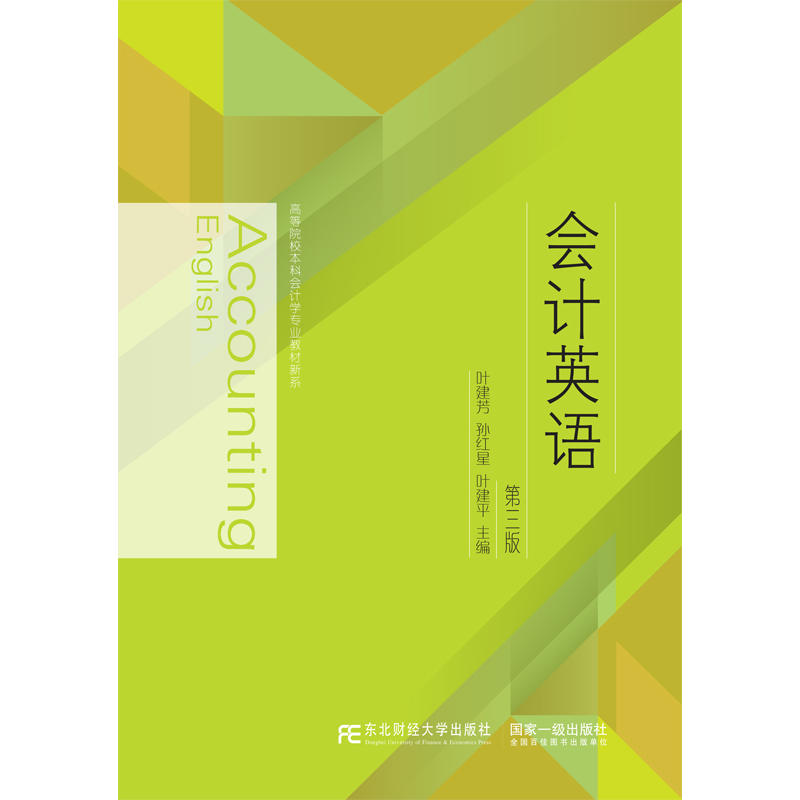- ISBN:9787565429774
- 装帧:一般胶版纸
- 册数:暂无
- 重量:暂无
- 开本:32开
- 页数:291
- 出版时间:2017-12-01
- 条形码:9787565429774 ; 978-7-5654-2977-4
本书特色
本书根据会计英语的读者一般具有一定的专业知识的特点,集教材与工具用书于一体,从会计等式出发,结合企业的经营活动,完整介绍了借贷记账法下的会计循环程序,包括企业分析、序时日记账填制、过入总分类账、期末账项调整、结账和财务报表编制等;并按资产、负债和权益要素,介绍了现金、短期投资和应收款项、存货和销售成本、长期投资、固定资产和无形资产、流动及非流动负债、股东权益等的会计处理要点,介绍了现金流量表的性质和编制方法,并提供了中英文对照的财务报表附注及各纳税申报表,同时根据我国会计准则建设与国际会计准则趋同的*情况以及“营改增”的*变化,做了及时修订,系统阐述了国际会计准则下的财务报表编报框架以及财务信息质量特征。本书可作为普通高等院校的教学用书,也可供会计专业人员自学使用,还可作为工具书使用。
内容简介
本书根据会计英语的读者一般具有一定的专业知识的特点,集教材与工具用书于一体,从会计等式出发,结合企业的经营活动,完整介绍了借贷记账法下的会计循环程序,包括企业分析、序时日记账填制、过入总分类账、期末账项调整、结账和财务报表编制等;并按资产、负债和权益要素,介绍了现金、短期投资和应收款项、存货和销售成本、长期投资、固定资产和无形资产、流动及非流动负债、股东权益等的会计处理要点,介绍了现金流量表的性质和编制方法,并提供了中英文对照的财务报表附注及各纳税申报表,同时根据我国会计准则建设与国际会计准则趋同的*新情况以及“营改增”的*新变化,做了及时修订,系统阐述了国际会计准则下的财务报表编报框架以及财务信息质量特征。本书可作为普通高等院校的教学用书,也可供会计专业人员自学使用,还可作为工具书使用。
目录
1? 2 Forms of Organization 1
1? 3 The Framework for the Preparation and Presentation of
Financial Statements 2
1? 4 Understanding of Financial Statements 5
1? 5 Accounting and Its Profession 9
1? 6 Accounting Elements and Using the Accounting Equation 10
1? 7 Professional Ethics in Accounting 12
1? 8 Convergence of Accounting Standards and Chinese Accounting Standards:
Development and Implementation 14
Vocabulary 18
Self?test Questions 20
Exercises 21
Answers to Self?test Questions 26
Chapter 2 Accounting Cycle 27
2? 1 T?account and Debit & Credit 27
2? 2 Journalizing and Posting Transactions 29
2? 3 Preparing a Trial Balance 33
2? 4 Adjusting the Accounts 34
2? 5 Adjusted Trial Balance and Preparation of Financial Statements 37
2? 6 The Worksheet 42
2? 7 Closing 45
2? 8 The Accounting Cycle Summary 47
2? 9 Classification of Statement of Financial Position Items 47
Vocabulary 49
Self?test Questions 50
Exercises 52
Answers to Self?test Questions 58
Chapter 3 Current Assets 59
3? 1 Cash 59
3? 2 Fair Value through Profit or Loss Investments 65
3? 3 Notes Receivable 66
3? 4 Accounts Receivable 69
3? 5 Inventories 73
Vocabulary 85
Self?test Questions 86
Exercises 87
Answers to Self?test Questions 91
Chapter 4 Non?current Assets 92
4? 1 Fixed Assets 92
4? 2 Natural Resources 103
4? 3 Intangible Assets 104
4? 4 Impairment of Fixed Assets 106
4? 5 Long?term Investments 107
4? 6 Impairment of Long?term Investments 115
Vocabulary 115
Self?test Questions 117
Exercises 118
Answers to Self?test Questions 120
Chapter 5 Liabilities 121
5? 1 Current Liabilities 121
5? 2 Non?current Liabilities 127
Vocabulary 136
Self?test Questions 137
Exercises 138
Answers to Self?test Questions 141
Chapter 6 Owners’ Equity 142
6? 1 Forms of Organization 142
6? 2 Stockholders’ Rights 142
6? 3 Accounting for Stock Issues 143
6? 4 Treasury Stock 145
6? 5 Preferred Stock 147
6? 6 Dividends and Stock Splits 147
6? 7 Accounting for Retained Earnings 152
6? 8 Statement Presentation and Analysis 155
Vocabulary 158
Self?test Questions 159
Exercises 160
Answers to Self?test Questions 163
Chapter 7 Revenue and Expense Recognition and Income
Statement Presentation 164
7? 1 Revenue Recognition Concepts 164
7? 2 Revenue Recognition at Delivery 169
2 会计英语
7? 3 Revenue Recognition before Delivery 170
7? 4 Revenue Recognition after Delivery 170
7? 5 Long?term Contracts 174
7? 6 Revenue Recognition for Service Sales 176
7? 7 Recognition of Gains and Losses 179
7? 8 Expense Recognition 179
7? 9 Presentation of the Income Statement 185
Vocabulary 188
Self?test Questions 189
Exercises 190
Answers to Self?test Questions 194
Chapter 8 Statement of Cash Flows and Financial Statement Analysis 195
8? 1 Cash and Cash Equivalents 195
8? 2 Classification of Cash Receipts and Cash Payments 195
8? 3 Preparing Statement of Cash Flows—Direct Method 197
8? 4 Preparing Statement of Cash Flows—Indirect Method 201
8? 5 Determining Cash Flows from Investing Activities 203
8? 6 Determining Cash Flows from Financing Activities 207
8? 7 Presenting the Information in the Form of the Statement of Cash Flows 208
8? 8 Usefulness of the Statement of Cash Flows 211
8? 9 Financial Statement Analysis: Vertical and Horizontal 211
8? 10 Ratio Analysis 217
Vocabulary 221
Self?test Questions 222
Exercises 223
Answers to Self?test Questions 228
Appendix 229
1? Balance Sheet 229
2? Income Statement 231
3? Statement of Changes in Owners’ Equity 233
4? Statement of Cash Flows 235
5? The Disclosure of Supplementary Information to Statement of Cash Flows 239
6? Disclosure of Information and Accounts Required 241
7? VAT Return Form 270
8? Consumption Tax Return Form 278
9? Annual Return Form of the People?s Republic of China on Corporate Income Tax 280
10? Individual Income Tax Return Form 289
作者简介
叶建芳,博士,上海财经大学教授、博导,中国注册会计师、澳大利亚注册会计师,美国康涅狄格大学、华盛顿圣路易斯大学访问学者。主要从事国际会计和财务会计教学和研究。在“Journal of Accounting,Auditing and Finance”、“Journal of Business,Financa and Accounting”、《管理世界》、《会计研究》、《审计研究》、《财经研究》和《税务研究》等杂志发表论文多篇。 孙红星,上海财经大学讲师,加拿大注册会计师,英国南安普顿大学访问学者,从事会计英语教学。 叶建平,浙江工商大学副教授,被评为浙江工商大学十佳教师之一,从事英美语言文学教学和研究。
-

(平装)北大心理课
¥14.4¥45.0 -

北大人文课(平装)
¥14.4¥45.0 -

古代汉语(第四册)
¥15.1¥35.0 -

北大必修课:北大心理课
¥18.6¥49.0 -

德国经典知识大百科:你最想知道的为什么!
¥19.8¥62.0 -

哲学导论
¥27.3¥35.0 -

新世纪高等学校教材 心理学基础课系列教材普通心理学(第5版)/彭聃龄
¥38.2¥78.0 -

高等数学-上册-第七版
¥15.2¥47.6 -

经济法案例评析
¥27.3¥39.0 -

微观经济学分册-经济学原理-第7版
¥35.3¥72.0 -

社会文化符号学
¥14.8¥39.0 -

国际中文教育教学资源发展报告(2023)语合中心
¥64.8¥108.0 -
![[社版]大汉战神:霍去病传](/Content/images/nopic.jpg)
[社版]大汉战神:霍去病传
¥12.8¥40.0 -

动物生物化学 第三版
¥17.9¥36.5 -

家庭保洁技能手册
¥17.8¥46.8 -

森林经理学
¥30.3¥55.0 -

测树学(第4版)/李凤日/国家林业和草原局普通高等教育十三五规划教材
¥21.1¥62.0 -

博雅大学堂·哲学西方马克思主义概论(第2版)
¥45.5¥65.0 -

河神娶媳妇
¥12.2¥32.0 -

成本会计(第3版21世纪会计学系列教材)
¥10.6¥28.0










